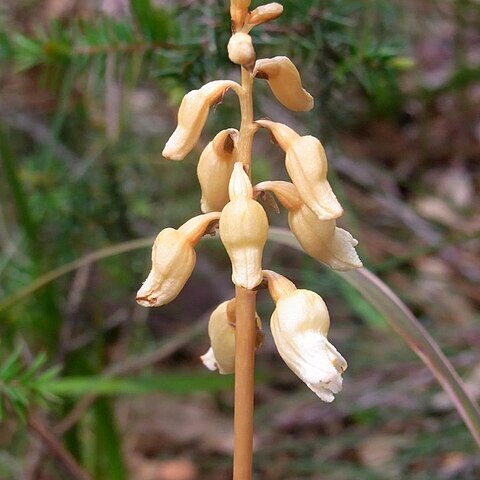Plant at fl. to c. 60–90 cm. tall. Swollen rhizomes large, e.g. individual parts to 8 × 3 cm. Stem erect, stout or slender (2–7 mm. diam.). Scale lvs widely spaced. Fls us. < 20, ± drooping to bring dorsal sepal next to axis. Per. c. 10–16 × 4–8 mm., light brownish; lobes slightly thickened marginally. Lateral sepals connate almost to level of labellum-tip. Labellum ovate-oblong, rather shortly adnate to per.-tube; long median calli much crested; margin well-developed, undulate and ± lobed, membr. above, thickened below, confined to free limb. Column almost as tall as labellum, very narrowly winged throughout; anther short, operculate, filament smooth; stigma basal, far below anther.
Flower stem 120–500 mm tall, slender, brown, fleshy, usually nodding when in bud, 4–25-flowered. Flowers tubular, pendulous, 16–20 mm long, externally grey to greyish brown, smooth to warty, internally crystalline white. Petal margins irregular or wavy. Labellum 9–11 × 4.5–6 mm, nearly triangular, white with orange margins, 3-lobed; lateral lobes with upturned, irregular margins; midlobe yellowish, with wide, angular to triangular basal margins, irregular towards apex. Callus of 2 prominent ridges, spreading then convergent, breaking up into irregular calli on midlobe, producing yellow pseudopollen. Column 6.5–7.5 × 2.5–3 mm, smooth; anther cap smooth.
A slender leafless ground orchid. It grows attached to and feeding on other plants. The plant is leafless. The rhizome under the ground is irregular in shape. The tuber is 2-10 cm across. It is brown and fleshy. The flower stem is 30-80 cm long. It is erect and dark brown. It is fleshy and has several bracts sheathing it. There are 3-75 flowers. These are nodding on flower stalks 0.3-1 cm long. The flowers are 1.5-2 cm long and bell shaped. They are brown and white. They have a sweet scent.
Slender, rhizomatous saprophyte to 1 m. Leaves reduced, scale-like, membranous. Flowers in a lax raceme, bell-shaped, not resupinate, patent or pendulous, light brown and cream-coloured, sepals and petals fused, lip free, 3-lobed with 2 crests.

